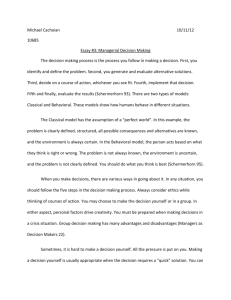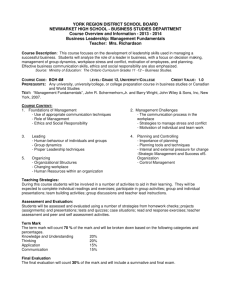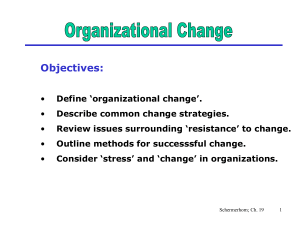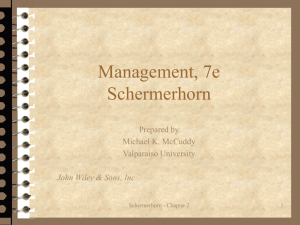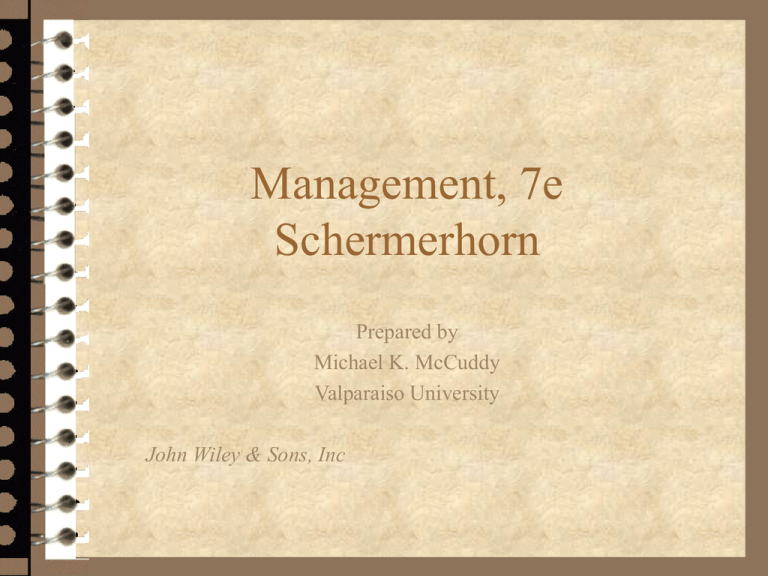
Management, 7e
Schermerhorn
Prepared by
Michael K. McCuddy
Valparaiso University
John Wiley & Sons, Inc
COPYRIGHT
Copyright 2002 © John Wiley & Sons, Inc. All rights reserved.
Reproduction or translation of this work beyond that named in
Section 117 of the United States Copyright Act without the express
written permission of the copyright owner is unlawful. Requests for
further information should be addressed to the Permissions
Department, John Wiley & Sons, Inc. The purchaser may make backup copies for his/her own use only and not for distribution or resale.
The Publisher assumes no responsibility for errors, omissions, or
damages, caused by the use of these programs or from the use of the
information contained herein.
Chapter 10
Organizing
Planning ahead—study questions
– What is organizing as a management function?
– What are the major types of organization
structures?
– What are the new developments in organization
structures?
– What organizing trends are changing the
workplace?
Schermerhorn - Chapter 10
3
What is organizing as a management
function?
Organizing and organization structure
– Organizing
• The process of arranging people and other resources
to work together to accomplish a goal.
– Organization structure
• The system of tasks, workflows, reporting
relationships, and communication channels that link
together diverse individuals and groups.
Schermerhorn - Chapter 10
4
What is organizing as a management
function?
Organization chart
– A diagram describing reporting relationships
and the formal arrangement of work positions
within an organization.
– An organization chart identifies …
•
•
•
•
•
The division of work
Supervisory relationships
Communication channels
Major subunits
Levels of management
Schermerhorn - Chapter 10
5
What is organizing as a management
function?
Formal and informal structures
– Formal structure
• The structure of the organization in its official state.
– Informal structure
• A “shadow” organization made up of the unofficial
working relationships between organization
members.
Schermerhorn - Chapter 10
6
What is organizing as a management
function?
Advantages of informal structures …
– Helping people accomplish their work.
– Overcoming limits of formal structure.
– Gaining access to interpersonal networks.
– Connecting with people who can assist in task
performance.
Schermerhorn - Chapter 10
7
What is organizing as a management
function?
Disadvantages of informal structures …
– May work against best interests of entire
organization.
– Susceptibility to rumor.
– May carry inaccurate information.
– Resistance to change.
– Diversion of work efforts from important
objectives.
– Feeling of alienation by outsiders.
Schermerhorn - Chapter 10
8
What are the major types of organization
structures?
Functional structures
– People with similar skills and performing
similar tasks are grouped together into work
units.
– Are not limited to businesses.
– Work well for small organizations producing
few products or services.
Schermerhorn - Chapter 10
9
What are the major types of organization
structures?
Advantages of functional structures …
– Economies of scale.
– Task assignments consistent with expertise and
training.
– High-quality technical problem solving,
– In-depth training and skill development.
– Clear career paths within functions.
Schermerhorn - Chapter 10
10
What are the major types of organization
structures?
Disadvantages of functional structures …
– Difficulties in pinpointing responsibilities.
– Functional chimneys problem.
– Sense of cooperation and common purpose
break down.
– Narrow view of performance objectives.
– Excessive upward referral of decisions.
Schermerhorn - Chapter 10
11
What are the major types of organization
structures?
Divisional structures
– Group together people who work on the same
product or process, serve similar customers,
and/or are located in the same area or
geographical region.
– Common in complex organizations.
– Avoid problems associated with functional
structures.
Schermerhorn - Chapter 10
12
What are the major types of organization
structures?
Advantages of divisional structures …
– More flexibility in responding to environmental
changes.
– Improved coordination.
– Clear points of responsibility.
– Expertise focused on specific customers,
products, and regions.
– Greater ease in restructuring.
Schermerhorn - Chapter 10
13
What are the major types of organization
structures?
Disadvantages of divisional structures …
– Duplication of resources and efforts across
divisions.
– Competition and poor coordination across
divisions.
– Emphasis on divisional goals at expense of
organizational goals.
Schermerhorn - Chapter 10
14
What are the major types of organization
structures?
Types of divisional structures and how they group
job and activities:
– Product structures focus on a single product or service.
– Geographical structures focus on the same location or
geographical region.
– Customer structures focus on the same customers or
clients.
– Process structures focus on the same processes.
Schermerhorn - Chapter 10
15
What are the major types of organization
structures?
Matrix structure
– Combines functional and divisional structures to gain
advantages and minimize disadvantages of each.
– Used in:
•
•
•
•
•
•
Manufacturing
Service industries
Professional fields
Non-profit sector
Multi-national corporations
Organizations pursuing growth strategies in dynamic and
complex environments
Schermerhorn - Chapter 10
16
What are the major types of organization
structures?
Advantages of matrix structures …
– Better interfunctional cooperation.
– Increased flexibility in restructuring.
– Better customer service.
– Better performance accountability.
– Improved decision making.
– Improved strategic management.
Schermerhorn - Chapter 10
17
What are the major types of organization
structures?
Disadvantages of matrix structures …
– Two-boss system is susceptible to power
struggles.
– Two-boss system can create task confusion and
conflict in work priorities.
– Team meetings are time consuming.
– Team loyalties may cause loss of focus on
organizational goals.
– Increased costs.
Schermerhorn - Chapter 10
18
What are the new developments in
organization structures?
Guidelines for horizontal structures:
–
–
–
–
–
–
–
–
Focus the organization around processes, not functions.
Put people in charge of core processes.
Decrease hierarchy and increase the use of teams.
Empower people to make decisions critical to performance.
Utilize information technology.
Emphasize multiskilling and multiple competencies.
Teach people how to work in partnership with others.
Build a culture of openness, collaboration, and performance
commitment.
Schermerhorn - Chapter 10
19
What are the new developments in
organization structures?
Team structures
– Extensively use permanent and temporary
teams to solve problems, complete special
projects, and accomplish day-to-day tasks.
– Often use cross-functional teams.
Schermerhorn - Chapter 10
20
What are the new developments in
organization structures?
Advantages of team structures …
– Eliminates barriers between operating
departments.
– Improved morale due to cross-functional
interaction.
– Improved quality and speed of decision
making.
– Increased enthusiasm for work.
Schermerhorn - Chapter 10
21
What are the new developments in
organization structures?
Disadvantages of team structures …
– Conflicting loyalties among members.
– Excessive time spent in meetings.
– Effective use of time depends on quality of
interpersonal relations, group dynamics, and
team management.
Schermerhorn - Chapter 10
22
What are the new developments in
organization structures?
Network structures
– A central core that is linked through networks
of relationships with contractors and outside
suppliers of essential services.
– Use communications and information
technology to support shifting strategic
alliances and strategic contracts.
Schermerhorn - Chapter 10
23
What are the new developments in
organization structures?
Advantages of network structures …
– Firms can operate with fewer full-time
employees and less complex internal systems.
– Reduced overhead costs and increased
operating efficiency.
– Permits operations across great distances.
Schermerhorn - Chapter 10
24
What are the new developments in
organization structures?
Disadvantages of network structures …
– Control and coordination problems may arise
from network complexity.
– Potential loss of control over outsourced
activities.
– Potential lack of loyalty among infrequently
used contractors.
Schermerhorn - Chapter 10
25
What are the new developments in
organization structures?
Boundaryless organizations
– Organizations in which teamwork and intense
communication take the place of formal lines of
authority.
– Break down internal boundaries.
– Key requirements:
• Absence of hierarchy
• Empowerment of team members
• Acceptance of impermanence
Schermerhorn - Chapter 10
26
What are the new developments in
organization structures?
Virtual organization
– A special form of boundaryless organization.
– An organization that operates in a shifting
network of external strategic alliances that are
engaged as needed, and typically supported by
extensive IT utilization.
Schermerhorn - Chapter 10
27
What organizing trends are changing the
workplace?
Contemporary organizing trends include:
– Shorter chains of command
– Less unity of command
– Wider spans of control
– More delegation and empowerment
– Decentralization with centralization
– Reduced use of staff
Schermerhorn - Chapter 10
28
What organizing trends are changing the
workplace?
Shorter chains of command
– The line of authority that vertically links all
persons with successively higher levels of
management.
– Current organizing trend:
• Organizations are being “streamlined” by cutting
unnecessary levels of management.
• Flatter structures are viewed as a competitive
advantage.
Schermerhorn - Chapter 10
29
What organizing trends are changing the
workplace?
Less unity of command
– Each person in an organization should report to
one and only one supervisor.
– Current organizing trend:
• Organizations are using more cross-functional
teams, task forces, and horizontal structures.
• Organizations are becoming more customer
conscious.
• Employees often find themselves working for more
than one boss.
Schermerhorn - Chapter 10
30
What organizing trends are changing the
workplace?
Wider spans of control
– The number of persons reporting directly to a
manager.
– Current organizing trend:
• Organizations are shifting to wider spans of control
as chains of command are shortened and
empowerment gains prominence.
• Managers have responsibility for a larger number of
subordinates who operate with less direct
supervision.
Schermerhorn - Chapter 10
31
What organizing trends are changing the
workplace?
More delegation and empowerment
– Delegation is the process of entrusting work to
others by giving them the right to make
decisions and take action.
– The manager assigns responsibility, grants
authority to act, and creates accountability.
– Current organizing trend:
• Managers are delegating more and finding more
ways to empower people at all levels.
Schermerhorn - Chapter 10
32
What organizing trends are changing the
workplace?
Ground rules for effective delegation:
–
–
–
–
–
–
–
–
–
–
–
Carefully choose the person to whom you delegate.
Define the responsibility; make the assignment clear.
Agree on performance objectives and standards.
Agree on a performance timetable.
Give authority; allow the other person to act independently.
Show trust in the other person.
Provide performance support.
Give performance feedback
Recognize and reinforce progress.
Help when things go wrong.
Don’t forget your accountability for performance results.
Schermerhorn - Chapter 10
33
What organizing trends are changing the
workplace?
Decentralization with centralization
– Centralization is the concentration of
authority for making most decisions at
the top levels of the organization.
– Decentralization is the dispersion of
authority to make decisions throughout
all levels of the organization.
Schermerhorn - Chapter 10
34
What organizing trends are changing the
workplace?
Decentralization with centralization
– Current organizing trend:
• Empowerment and related forces contribute
to more decentralization in organizations.
• Advances in information technology allow
for the retention of centralized control.
Schermerhorn - Chapter 10
35
What organizing trends are changing the
workplace?
Reduced use of staff
– Specialized staff—people who perform a
technical service or provide special problemsolving expertise to other parts of the
organization.
– Personal staff—people working in “assistantto” positions that provide special support to
higher-level positions.
Schermerhorn - Chapter 10
36
What organizing trends are changing the
workplace?
Current organizing trend:
– Organizations are reducing the size of staff.
– Organizations are seeking increased operating
efficiency by employing fewer staff personnel
and smaller staff units.
Schermerhorn - Chapter 10
37

